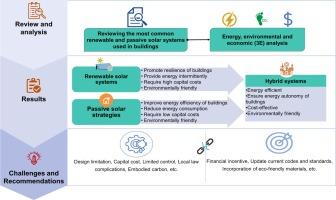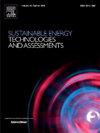建筑一体化被动和可再生太阳能技术:从 3E 角度回顾
IF 7.1
2区 工程技术
Q1 ENERGY & FUELS
Sustainable Energy Technologies and Assessments
Pub Date : 2024-11-14
DOI:10.1016/j.seta.2024.104079
引用次数: 0
摘要
建筑业是目前能源最密集的行业之一,因此必须采用可持续能源做法来满足高能源需求和应对气候变化的挑战。在这方面,太阳能技术(包括可再生能源和被动式太阳能)已成为前景广阔的解决方案。本文全面评述了普遍采用的被动式和可再生太阳能系统在能源、经济和环境(3E)方面的性能,包括单独使用和与建筑物结合使用。本文还深入探讨了与这些系统相关的优势、局限性和挑战。此外,还强调了许多相关建议,以提高这些系统的整体性能,促进建筑物的可持续发展。研究结果表明,在所比较的太阳能系统中,光电热能技术的整体能效最高,从 58% 到 94% 不等。在经济和环境方面,光伏发电、光热发电和太阳能热水器都取得了卓越的成果。相反,大多数基于太阳能的被动式策略既节能又环保,而一些被动式方法,如 Trombe 墙和绿化,则不符合成本效益。然而,太阳能技术的 3E 效率在很大程度上取决于多种因素,如天气条件、能源价格、资本成本和碳含量。因此,选择合适的能源系统对于建造更可持续、更高效和更有弹性的建筑至关重要,这对环境和居住者都有好处。本文章由计算机程序翻译,如有差异,请以英文原文为准。

Building-integrated passive and renewable solar technologies: A review from 3E perspectives
Building is currently one of the most energy-intensive sectors, necessitating the integration of sustainable energy practices to meet the high energy demand and address climate change challenges. In this regard, solar energy technologies, both renewable and passive, have emerged as promising solutions. This paper comprehensively reviews the energy, economic and environmental (3E) performance of prevalent passive and renewable solar systems, separately and combined, integrated into buildings. The advantages, limitations, and challenges associated with these systems are also thoroughly explored. Furthermore, many relevant recommendations to improve their overall performance and promote the sustainability of buildings are highlighted. The findings reveal that photovoltaic thermal technology provides the highest overall energy efficiency, ranging from 58% to 94%, amongst the compared solar systems. Economically and environmentally, photovoltaic, photovoltaic thermal and solar water heaters deliver excellent outcomes. Conversely, most solar-based passive strategies are energy-efficient and environmentally friendly, while some passive methods, such as Trombe wall and greening, are not cost-effective. However, the 3E efficiency of solar technologies largely depends on several factors, such as weather conditions, energy prices, capital costs and carbon content. Therefore, selecting appropriate energy systems is essential for constructing more sustainable, efficient and resilient buildings that benefit both the environment and occupants.
求助全文
通过发布文献求助,成功后即可免费获取论文全文。
去求助
来源期刊

Sustainable Energy Technologies and Assessments
Energy-Renewable Energy, Sustainability and the Environment
CiteScore
12.70
自引率
12.50%
发文量
1091
期刊介绍:
Encouraging a transition to a sustainable energy future is imperative for our world. Technologies that enable this shift in various sectors like transportation, heating, and power systems are of utmost importance. Sustainable Energy Technologies and Assessments welcomes papers focusing on a range of aspects and levels of technological advancements in energy generation and utilization. The aim is to reduce the negative environmental impact associated with energy production and consumption, spanning from laboratory experiments to real-world applications in the commercial sector.
 求助内容:
求助内容: 应助结果提醒方式:
应助结果提醒方式:


